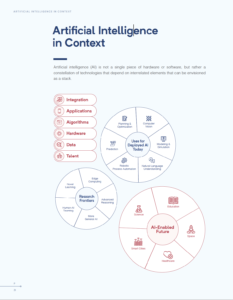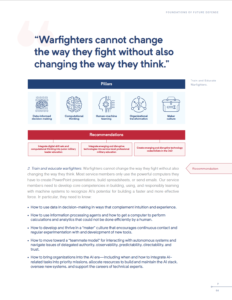March 23, 2021
AI Commission Makes Bold Funding Recommendations


The National Security Commission on Artificial Intelligence (NSCAI) was established by the National Defense Authorization Act of 2019 as a bipartisan fifteen-member commission to “consider the methods and means necessary to advance the development of artificial intelligence, machine learning, and associated technologies to comprehensively address the national security and defense needs of the U.S.” The Commission published its 752-page final report on March 1.
Americans have not yet grappled with just how profoundly the artificial intelligence (AI) revolution will impact our economy, national security, and welfare. Much remains to be learned about the power and limits of AI technologies. Nevertheless, big decisions need to be made now to accelerate AI innovation to benefit the United States and to defend against the malign uses of AI.
NSCAI Final Report, March 1
The report found that the U.S. is not prepared to defend or compete in the AI arena. It advocates a whole-of-nation effort with a strategy to defend against AI and responsible employment of AI for national security to win the “broader technology competition.”
The goal the Commission sets for the Department of Defense (DoD) and the Intelligence Community (IC) is to be “AI-ready” by 2025. Achieving that objective requires cooperation and coordination of partners in industry, academia, and civil society. The Commission calls for four initial areas of action: 1) commitment from leaders in the U.S. Government to take AI competition seriously, 2) creating a talent pipeline to secure an AI workforce, 3) revitalizing domestic chip manufacturing with a robust $35 billion federal investment, and 4) spending $40 billion to expand and democratize federal AI research and development.
The report is divided into two sections, the first being “Defending America in an AI Era,” which examines how the U.S. can defend against the full spectrum of AI threats from both state and non-state actors and how the U.S. can responsibly use AI technologies to protect America and our interests. The second section, “Winning the Technology Competition,” examines AI’s role in the broader technology competition (primarily with China) and addresses critical elements of that competition. The authors of the report use Thomas Edison’s early thoughts on the potential of electricity to change the world as a comparison for the impact they believe AI will have.
Thomas Edison said of electricity that it “is the field of fields. It holds the secrets which will reorganize the life of the world.
NSCAI Final Report, March 1
The report contains several appendices including suggested legislative language for its recommendations (appendix D) and a summary by chapter of its funding recommendations (appendix E). We have sorted the funding recommendations (Chart I ) by agency to provide a better illustration of the recommendations’ impact upon agency budgets. Because the NSCAI report was released prior to President Biden’s first budget, we do not yet know whether his FY22 budget will include any of these recommendations.
NSCAI Spending Recommendations by Agency
|
||
Agency and Component/Program |
FY22 |
Outyears |
| DoD | ||
| DARPA | 500 | 4,600 |
| Research and Engineering | 225 | |
| Research and Development | 8,000 | |
| Chief Data Officer | 125 | |
| Joint Artificial Intelligence Center | 100 | |
| Joint Warfare Analysis Center | 2.5 | |
| OUSD AS | 100 | |
| CIO | 5 | |
| STEM Corps (establishment) | 5 | 5 |
| ODNI | ||
| IC Funding for IT | 1,000 | 9,000 |
| Foreign Malign Influence Response | 30 | |
| DHS | ||
| Cyber Defense | 10 | |
| NIST | ||
| AI Testbed | 25 | |
| Third Party Testing | 1 | |
| Regional Innovation Clusters | * | 200 |
| Advanced Packaging | 1,000 | 4,000 |
| Cyberspace Solarium | ||
| Solar Winds Threat Review | 7 | |
| Multiple Agency | ||
| Appoint AI Leads for National Security | 22 | |
| National Defense Education Act | 8,200 | |
| Increase Non-Defense AI R&D | 2,000 | 60,000 |
| National Semiconductor Technology Center | 100 | 1,900 |
| AI Standards | 3.3 | |
| Multilateral AI Research Initiative | 12 | 61 |
| Trusted Learning Cloud | 11 | |
| Executive Office of the President | ||
| OMB – Reserve Digital Corps | 16 | |
| Technology Competitiveness Council | 2 | |
| Department of Energy | ||
| AI Data Program | 25 | |
| Semiconductor Research | 400 | 4,100 |
| Department of Commerce | ||
| Microelectronics Manufacturing Grants | 15,000 | |
| Small Business Administration | ||
| Small Business International Standards | 1 | |
| National Science Foundation | ||
| AI Research Institute Network | 200 | 400 |
| AI Innovator Award | 125 | |
| Team-Based AI Award | 50 | 1,200 |
| NAIRR Roadmap | 30 | |
| Open Knowledge Network | 25 | |
| NSF Semiconductor Research | 300 | 2,200 |
| U.S. Center of Expertise GPAI/OECD | 1 | |
| Department of State | ||
| Technology Infrastructure Project | 1,000 | |
| Development Financing Incentives | 200 | |
| U.S. AID Digital Strategy | 200 | |
| International Data and Tech Standards Grants | 5 | |
| AI Training for Diplomatic Corps | 8 | |
| Cyberspace Security & Emerging Technology | 20 | |
| Diplomacy AI Innovation & Democratic Values | 6 | |
| AI Exchange Programs U.S. Values | 9 | |
| Efforts to Promote U.S. Innovation | 3 | |
| Tracking Impact of Engagement Efforts | 1 | |
| U.S. Science Envoys | 1 | |
| Emerging Technology Coalition & Internal Programs | 6 | |
| Human Rights in AI Context | 2 | |
| National Security Cooperation | 3 | |
| Tech. Capacity in Emerging Democracies | 3 | |
| Grants for Malign Influence in AI | 2 | |
| Public Diplomacy AI Standards | 2 | |
| Global Innovation through S&T | 1 | |
| Digital Programs (rule of law, democracy and human rights, security cooperation, technical assistance) | 230 | |
| New Entries | ||
| National Technology Foundation | 1,030 | 50,000 |
| Digital Service Academy | 40 | |
Chart I. Source: NSCAI Final Report, Appendix E. *$200 million FY22-26, $20 million per cluster.
On March 12, the House Committee on Armed Services’ Subcommittee on Cyber, Innovative Technologies and Information Systems held a joint hearing with the House Committee on Oversight and Reform’s Subcommittee on National Security with the Chair, Vice Chair and two members of the NSCAI to discuss its recommendations. There were no questions directly relating to the overall funding recommendations. Much of the hearing focused on the IT workforce, the talent deficit NSCAI identified, and its recommendations for making the workforce more robust and competitive by implementing, among other things, a Digital Service Academy.
Former Deputy Secretary of Defense Robert Work, now the Commission Vice Chair, argued that adversaries plan to defeat the U.S. military through the use of better operational systems and suggested that DoD shift its thinking away from platforms to systems, or in other words, from hardware to software. Gilman Louie, a Commission member, technology venture capitalist, and founder of In-Q-Tel, stated that the United States tends “to look at cybersecurity breaches as an IT problem. Our adversaries look
at it as domain warfare….” He testified that we are losing technology to foreign governments because the Committee on Foreign Investment in the United States (CFIUS) requirements are voluntary and recommended mandatory disclosure for any foreign investment in AI, quantum computing, and microelectronics.
The overall awareness and discussion of the NSCAI report suggest that members of both subcommittees take many of these findings seriously. The subcommittees supported the overall thrust of the report, which is to move the U.S. government into a higher gear when addressing AI. FBIQ believes the Commission’s $170 billion-plus multi-year funding recommendations should be viewed as aspirational. Budgetary restrictions limit Congress’s ability to approve NSCAI proposals.
Excerpts from the NSCAI Final Report:

